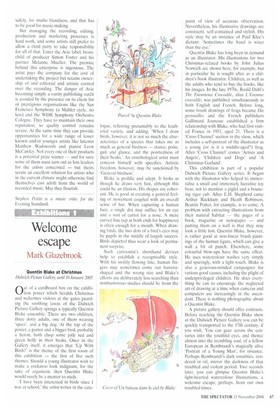Welcome escape
Mark Glazebrook
Quentin Blake at Christmas Duhvich Picture Galloy, until lb Janualy 2005 Qtd. of a cardboard box on the exhibiV./bon poster which heralds Christmas and welcomes visitors at the gates guarding the soothing lawns of the Dulwich Picture Gallery springs a typically Quentin Blake ensemble. There are two children, three dotty adults, one of them wearing 'specs', and a big dog. At the top of the poster, a parrot and a bigger bird, probably a heron, both clasp some jolly red and green holly in their beaks. Once in the Gallery itself, it emerges that 'Up With Birds!' is the theme of the first room of this exhibition — the first of five such themes. Should a young illustrator wish to make a cockatoo look indignant, for the sake of argument, then Quentin Blake would surely be a mentor to study.
'I have been interested in birds since I was at school,' the artist writes in the cata logue, referring presumably to the feathered variety, and adding, 'When I draw birds, however, it is not so much the characteristics of a species that takes me as much as general birdness — stance, poise, gait and glance, and the pointedness of their beaks.' An ornithological artist must concern himself with specifics. Artistic freedom, however, may be sanctioned by 'General birdness'.
Blake is prolific and adept. It looks as though he draws very fast, although this could be an illusion. His shapes are coherent. He is good at creating a general feeling of movement coupled with an overall sense of fun. When capturing a human face, a single dot may suffice for an eye and a sort of carrot for a nose. A mere curved line (up at both ends for happiness) is often enough for a mouth. When drawing birds, the two dots of a bird's eyes may be pupils in the middle of largish saucers. Birds depicted thus wear a look of permanent surprise.
Such cartoonist's shorthand devices help to establish a recognisable style. With his swiftly flowing line, human fingers may sometimes come out bananashaped and the wrong size and Blake's efforts are deliberately less searching than nonhumorous studies should be from the point of view of accurate observation. Nevertheless, his illustrative drawings are consistent, self-contained and stylish. His style may he an instance of Paul Klee's dictum: 'Sometimes the hand is wiser than the eye.'
Quentin Blake has long been in demand as an illustrator. His illustrations for two Christmas-related books by John Julius Norwich are shown here, for example, but in particular he is sought after as a children's book illustrator. Children, as well as the adults who tend to buy the books, like his images. In the late 1970s. Roald Dahl's The Enormous Crocodile, alias L'Enorme crocodile, was published simultaneously in both English and French. Before long, some brush drawings of frogs became Dix grenouilles and the French publishers Gallimard Jeunesse established a firm relationship with Blake, who had first visited France in 1951, aged 21. There is a 'Cross Channel' section in the show, which includes a self-portrait of the illustrator as a young (or is it a middle-aged?) frog. After 'Cross Channel' comes 'Artists and Angels', 'Children and Dogs' and 'A Christmas Garland'.
This exhibition is part of a popular Dulwich Picture Gallery series. It began with the illustrator who helped to immortalise a small and immensely lucrative toy bear, not to mention a piglet and a bouncing tiger cub. After E.H. Shepherd came Arthur Rackham and Heath Robinson. Beatrix Potter, for example, is to come. A problem with extracting illustrations from their natural habitat — the pages of a book, magazine or newspaper — and putting them on a wall is that they may look a little lost. Quentin Blake, however, is rather good at non-linear brush paintings of the human figure, which can give a wall a bit of punch. Elsewhere, some colourful blow-ups have the same effect. He uses watercolour washes very simply and sparingly, with a light touch. Blake is also a generous-minded campaigner for various good causes, including the plight of underprivileged children. He does everything he can to encourage the neglected art of drawing at a time when cameras and computers are increasingly in the ascendant. There is nothing photographic about a Quentin Blake.
A picture gallery should offer contrasts. Before reaching the Quentin Blake show at the Dulwich Picture Gallery you can be quickly transported to the 17th century, if you wish. You can gaze across the centuries into the youthful eyes, and thence almost into the trembling soul, of a fellow European in Rembrandt's magically alive 'Portrait of a Young Man', for instance. Perhaps Rembrandt's dark tonalities, rendered in oil, mirror the darkness of that troubled and violent period. Two seconds later, you can glimpse Quentin Blake's light-hearted watercolour illustrations, a welcome escape, perhaps, from our own troubled times.


























































































 Previous page
Previous page